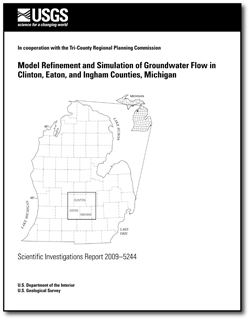Scientific Investigations Report 2009–5244
Abstract
A groundwater-flow model that was constructed in 1996 of the Saginaw aquifer was refined to better represent the regional hydrologic system in the Tri-County region, which consists of Clinton, Eaton, and Ingham Counties, Michigan. With increasing demand for groundwater, the need to manage withdrawals from the Saginaw aquifer has become more important, and the 1996 model could not adequately address issues of water quality and quantity. An updated model was needed to better address potential effects of drought, locally high water demands, reduction of recharge by impervious surfaces, and issues affecting water quality, such as contaminant sources, on water resources and the selection of pumping rates and locations. The refinement of the groundwater-flow model allows simulations to address these issues of water quantity and quality and provides communities with a tool that will enable them to better plan for expansion and protection of their groundwater-supply systems. Model refinement included representation of the system under steady-state and transient conditions, adjustments to the estimated regional groundwater-recharge rates to account for both temporal and spatial differences, adjustments to the representation and hydraulic characteristics of the glacial deposits and Saginaw Formation, and updates to groundwater-withdrawal rates to reflect changes from the early 1900s to 2005. Simulations included steady-state conditions (in which stresses remained constant and changes in storage were not included) and transient conditions (in which stresses changed in annual and monthly time scales and changes in storage within the system were included). These simulations included investigation of the potential effects of reduced recharge due to impervious areas or to low-rainfall/drought conditions, delineation of contributing areas with recent pumping rates, and optimization of pumping subject to various quantity and quality constraints. Simulation results indicate potential declines in water levels in both the upper glacial aquifer and the upper sandstone bedrock aquifer under steady-state and transient conditions when recharge was reduced by 20 and 50 percent in urban areas. Transient simulations were done to investigate reduced recharge due to low rainfall and increased pumping to meet anticipated future demand with 24 months (2 years) of modified recharge or modified recharge and pumping rates. During these two simulation years, monthly recharge rates were reduced by about 30 percent, and monthly withdrawal rates for Lansing area production wells were increased by 15 percent. The reduction in the amount of water available to recharge the groundwater system affects the upper model layers representing the glacial aquifers more than the deeper bedrock layers. However, with a reduction in recharge and an increase in withdrawals from the bedrock aquifer, water levels in the bedrock layers are affected more than those in the glacial layers. Differences in water levels between simulations with reduced recharge and reduced recharge with increased pumping are greatest in the Lansing area and least away from pumping centers, as expected. Additionally, the increases in pumping rates had minimal effect on most simulated streamflows. Additional simulations included updating the estimated 10-year wellhead-contributing areas for selected Lansing-area wells under 2006–7 pumping conditions. Optimization of groundwater withdrawals with a water-resource management model was done to determine withdrawal rates while minimizing operational costs and to determine withdrawal locations to achieve additional capacity while meeting specified head constraints. In these optimization scenarios, the desired groundwater withdrawals are achieved by simulating managed wells (where pumping rates can be optimized) and unmanaged wells (where pumping rates are not optimized) and by using various combinations of existing and proposed well locations. |
First posted May 5, 2010 For additional information contact: Part or all of this report is presented in Portable Document Format (PDF); the latest version of Adobe Reader or similar software is required to view it. Download the latest version of Adobe Reader, free of charge. |
Luukkonen, C.L., 2009, Model refinement and simulation of groundwater flow in Clinton, Eaton, and Ingham Counties, Michigan: U.S. Geological Survey Scientific Investigations Report 2009–5244, 53 p.
Acknowledgments
Abstract
Introduction
Description of Study Area
Groundwater-Flow Models
Groundwater-Flow Simulations
Model Assumptions and Limitations
Summary and Conclusions
References Cited
Appendix 1. Chemistry of Lansing Area Well Water